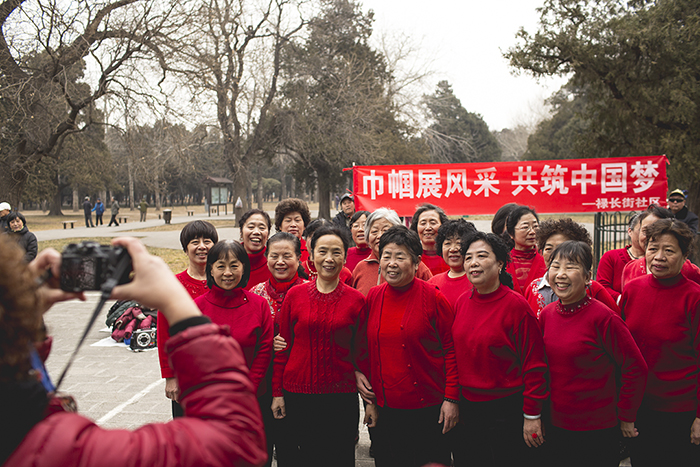Dancing in the Park: People, Past, and Prospect

The 2014 Smithsonian Folklife Festival created a People’s Park, bringing dancing, games, and sports to the shaded area on the National Mall. In an earlier blog post, China: Tradition and the Art of Living co-curator Sojin Kim revealed the idea behind this project and how visitors engaged in this imagined space. In fact, almost all the foreigners I worked with while in China expressed to me their enthusiasm for this popular form of public entertainment. From fielding their questions, it has occurred to me that there is more meaning behind this dancing than is immediately apparent.
Dancing in the park is a fairly new phenomenon, and its development is related to other things such as urbanization across the country and changing demographics and family structure in China. The dancers are disproportionately women, either retirees or housewives. China currently has an early retirement age compared to other industrialized societies—fifty-five for women (fifty for those in blue-collar jobs) and sixty for men.
Born in the late 1950s and early 1960s, they are the first generation of parents under the one-child policy, mandated nationwide since 1979. Today, the only child in each nuclear family has become an adult, more likely to work in a big city far away from his or her hometown, and, if married, usually the parent of only one child. Even though the one-child policy was relaxed in 2013, young couples still normally have one child due to the cost of raising children and the concern that many women have regarding their career development.
These circumstances have resulted in releasing new grandparents from the burden of babysitting. Otherwise, in a traditional family-oriented society with no population control policy, seniors were typically busy caring for their grandchildren. My grandmother, born in the late 1920s, for example, spent over two decades taking care of me and my cousins. Dancing in the park was not a recreational option for her.
While it may look quite exciting for foreigners, what this dancing means to common Chinese people, like my parents, is that life has improved. People born in the 1950s and 1960s lived through the hardest time after the founding of the People’s Republic of China in 1949. Urban and rural, educated and uneducated, these generations lived through the hunger under the planned economy, political movements like the Cultural Revolution, and finally economic and social reforms after 1978.
As compared with the past, the material life today is much better and the political environment more stable. “They deserve to enjoy life now,” my father used to say as we watched people dancing in the park before I came to the States. “You may not understand it. The happiness is truly from the heart.” Even my mother, who does not have time to join the dancing, enjoys watching for a few minutes and continues to hum the music when she’s back at home.
As a British woman working in China for six months shared with China Daily, “What amazed me more than anything else was the undeniable sense of joy and total lack of self-consciousness.” People share the joy in so many parks across the country that it becomes an integral part of the “art of living” in China.
I see dancing in the park from a different vantage point. As someone from the post-1990s generation, I have no interest in joining in. Nor do I know what the music played in the park is really about, other than there are some popular Chinese folk songs that I may recognize. In fact, I am impressed by people’s courage to practice their not-so-fluent dance steps in public. I would definitely shy away from participating in such displays, as would many of my peers.
But I can’t help thinking, after this generation ages and stays closer to home, will the dancing disappear in the many People’s Parks across China? When I am old, what will be the means through which my generation expresses itself? Will the social life and entertainment styles in the future converge with global trends in the same way that they have already done for the country’s young populations?
Qiaoyun Zhao is an intern with the Center for Folklife and Cultural Heritage. Originally from Nanjing, China, she is currently a graduate student in the University of Maryland, School of Public Policy. She finished her undergraduate study in Nanjing University before she came to United States in 2013.

